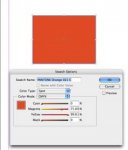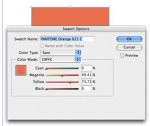Cross-referencing CMYK builds for other print conidtions, Part 1
Cross-referencing CMYK builds for other print conidtions, Part 1
First off, you're referring to *simulation* of spot colors using CMYK, correct? (I thought so!)

From a color management perspective this is a relatively simple thing to accomplish. It's going to require a few things though....you'll first need to determine what is going to be your "reference" color space (or printing condition if you will). This can then be used as a foundation for subsequent conversions or adjustments of these spot color CMYK builds for other printing processes. To start with, you'll need an ICC profile of this reference space. For the best chance of matching these builds from the get-go, let's say that reference space/profile is GRACoL Coated1 (nice wide color gamut of "normal" offset printing). I'll later get into why this might NOT be the best choice and what compromises you'll have to make....but this is a good reference to use to explain the basic concept.
At this point, if you know the CMYK build using, say, the Pantone Process Simulation Guide as a starting point, you would simply ASSIGN your reference profile to this build in, say, Adobe Photoshop, and have it tell you what the L*a*b* value is for that build with that particular profile (you can use Phototshop's Color Picker for this or the into palette if it's set to L*a*b*). Keep in mind that there's no guarantee this will match what you see in the Pantone book as we have no *precise* idea of what ICC profile might define the printing condition used for the Pantone CMYK builds (more on that later).
Once you know the L*a*b* value of the CMYK build relative to a reference color space/profile/printing condition, you can (in Photoshop) simply change your CMYK working space to your NEW printing condition profile, go into the Color Picker, type in the L*a*b* value and then look at the CMYK build it comes up with. These new values will likely be quite different than the first go-'round but this represents the CMYK build to match that color as close as possible with this new printing condition.
An alternate approach would be to create a blank L*a*b* document in Photoshop, fill it with the L*a*b* value you want and simply change change your CMYK working space at will and read out the CMYK equivalent from the Info palette (set first readout to Lab, the second to CMYK).
One other note, if you want THE most accurate rendering of that CMYK build, you should start by setting your default rendering intent in Color Settings to Absolute Colorimetric before doing any of this...this will ensure that the CMYK build that gets reported also takes into account the darkness and color tint of the printing stock, something that would be important for matching to newsprint....but be sure to set the rendering intent back to relative colorimetric (or perceptual) before you do any normal Photoshop work otherwise you'll be in for a big surprise!
That's the end of Part 1....on to Part 2 and Part 3
Regards,
Terry Wyse















